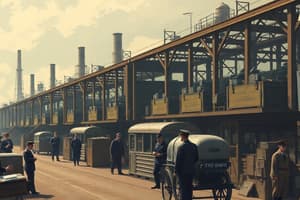Podcast
Questions and Answers
Which government agency was given new authority to convince more companies to convert to war production?
Which government agency was given new authority to convince more companies to convert to war production?
- The Reconstruction Finance Corporation (RFC) (correct)
- The Federal Reserve
- The Department of Defense
- The National Recovery Administration
Most companies initially preferred to continue producing consumer goods instead of military equipment.
Most companies initially preferred to continue producing consumer goods instead of military equipment.
True (A)
What major event changed the course of production in America, leading to widespread conversion to war production?
What major event changed the course of production in America, leading to widespread conversion to war production?
The Japanese attack on Pearl Harbor
The Reconstruction Finance Corporation (RFC) was permitted to make ______ to companies to help them convert to war production.
The Reconstruction Finance Corporation (RFC) was permitted to make ______ to companies to help them convert to war production.
Match the following terms with their corresponding definitions:
Match the following terms with their corresponding definitions:
The military consistently consulted with the WPB before signing contracts.
The military consistently consulted with the WPB before signing contracts.
What was the primary purpose of the Office of War Mobilization (OWM)?
What was the primary purpose of the Office of War Mobilization (OWM)?
Match the following government agencies with their primary roles in the war effort:
Match the following government agencies with their primary roles in the war effort:
The War Production Board was established after the bombing of Pearl Harbor.
The War Production Board was established after the bombing of Pearl Harbor.
What was a major challenge faced by business leaders during the conversion to wartime production?
What was a major challenge faced by business leaders during the conversion to wartime production?
What was a notable characteristic of Liberty ships that made them valuable during wartime?
What was a notable characteristic of Liberty ships that made them valuable during wartime?
The text suggests that the mobilization process for wartime production was smooth and efficient.
The text suggests that the mobilization process for wartime production was smooth and efficient.
What key advantage did the United States have over Germany in terms of military logistics?
What key advantage did the United States have over Germany in terms of military logistics?
The Liberty ship was a specialized aircraft carrier used during World War II.
The Liberty ship was a specialized aircraft carrier used during World War II.
Match the following terms with their descriptions:
Match the following terms with their descriptions:
Which of these is NOT a benefit of welded ships compared to riveted ships?
Which of these is NOT a benefit of welded ships compared to riveted ships?
Henry Ford's contributions to the war effort were solely focused on automobile production.
Henry Ford's contributions to the war effort were solely focused on automobile production.
The United States auto industry played a crucial role in producing military equipment during World War II.
The United States auto industry played a crucial role in producing military equipment during World War II.
What was the primary goal of the U.S. government regarding industry during World War II?
What was the primary goal of the U.S. government regarding industry during World War II?
The U.S. government discouraged automobile manufacturers from contributing to the war effort.
The U.S. government discouraged automobile manufacturers from contributing to the war effort.
What was the name of the enormous B-24 bomber assembly line created by Willow Run Airport near Detroit?
What was the name of the enormous B-24 bomber assembly line created by Willow Run Airport near Detroit?
Match the following government agencies with their primary function during World War II:
Match the following government agencies with their primary function during World War II:
The United States had a clear advantage in World War II because they could move troops and supplies faster than their opponents.
The United States had a clear advantage in World War II because they could move troops and supplies faster than their opponents.
What was the impact of the wartime economy on industrial production during World War II?
What was the impact of the wartime economy on industrial production during World War II?
Match the following aspects of the wartime economy with their descriptions:
Match the following aspects of the wartime economy with their descriptions:
Flashcards
Reconstruction Finance Corporation (RFC)
Reconstruction Finance Corporation (RFC)
A government agency established during the Depression, authorized to make loans to companies for converting to war production.
War Production Conversion
War Production Conversion
The shift of industries from making consumer goods to manufacturing military equipment.
Pearl Harbor Attack
Pearl Harbor Attack
The event on December 7, 1941, that catalyzed the U.S. to enter World War II and accelerated industrial conversion.
War materials production
War materials production
Signup and view all the flashcards
Economic effects of war production
Economic effects of war production
Signup and view all the flashcards
Liberty Ships
Liberty Ships
Signup and view all the flashcards
Henry Kaiser
Henry Kaiser
Signup and view all the flashcards
Welded vs. Riveted Ships
Welded vs. Riveted Ships
Signup and view all the flashcards
Mass Production
Mass Production
Signup and view all the flashcards
Artillery Production
Artillery Production
Signup and view all the flashcards
Kaiser's Shipyards
Kaiser's Shipyards
Signup and view all the flashcards
Military Equipment
Military Equipment
Signup and view all the flashcards
Production Techniques
Production Techniques
Signup and view all the flashcards
War Production Board (WPB)
War Production Board (WPB)
Signup and view all the flashcards
Office of War Mobilization (OWM)
Office of War Mobilization (OWM)
Signup and view all the flashcards
Military production goals
Military production goals
Signup and view all the flashcards
Conflict with military agencies
Conflict with military agencies
Signup and view all the flashcards
Production of tanks vs. automobiles
Production of tanks vs. automobiles
Signup and view all the flashcards
Impact of wartime industrial policies
Impact of wartime industrial policies
Signup and view all the flashcards
Commitment to winning the war
Commitment to winning the war
Signup and view all the flashcards
Welded Ships
Welded Ships
Signup and view all the flashcards
Tank Production (1941-1945)
Tank Production (1941-1945)
Signup and view all the flashcards
Mobilization Process
Mobilization Process
Signup and view all the flashcards
Frustrations in Production
Frustrations in Production
Signup and view all the flashcards
President Roosevelt's Actions
President Roosevelt's Actions
Signup and view all the flashcards
Order Priorities
Order Priorities
Signup and view all the flashcards
Wartime Production
Wartime Production
Signup and view all the flashcards
Automobile Production (1941-1945)
Automobile Production (1941-1945)
Signup and view all the flashcards
B-24 Bomber
B-24 Bomber
Signup and view all the flashcards
General George C. Marshall
General George C. Marshall
Signup and view all the flashcards
Military Equipment Production
Military Equipment Production
Signup and view all the flashcards
Automobile Industry's Role
Automobile Industry's Role
Signup and view all the flashcards
Effectiveness of Mobility
Effectiveness of Mobility
Signup and view all the flashcards
Production Statistics 1941-1945
Production Statistics 1941-1945
Signup and view all the flashcards
Mobilization for War
Mobilization for War
Signup and view all the flashcards
Cost-Plus
Cost-Plus
Signup and view all the flashcards
Disfranchise
Disfranchise
Signup and view all the flashcards
Incentive
Incentive
Signup and view all the flashcards
War Production Board
War Production Board
Signup and view all the flashcards
Selective Service and Training Act
Selective Service and Training Act
Signup and view all the flashcards
Reconstruction Finance Corporation
Reconstruction Finance Corporation
Signup and view all the flashcards
Study Notes
Mobilizing for War
- The US government supported industry to improve manufacturing for a wartime economy.
- Automakers and shipyards produced vehicles and equipment.
- African Americans and women contributed to the war effort despite limitations.
- The US government encouraged rapid economic mobilization.
Guiding the Wartime Economy
- Cost-plus contracts were used to speed up production. The government guaranteed payment for cost of production + a profit percentage.
- This incentivized companies, and prioritized production of war materials despite costs.
- The Reconstruction Finance Corporation (RFC) provided loans to assist companies in converting to war production.
- The War Production Board (WPB) was established to better manage resources. They set priorities and controlled the distribution of raw materials/supplies.
American War Production
- Automobile manufacturers were key to wartime production. They converted from civilian goods and rapidly ramped up production of military vehicles and equipment.
- Shipyards—particularly Henry Kaiser's—produced large numbers of Liberty ships. These ships were crucial for cargo transport. Key characteristic: welded hulls.
- The US industrial output during the war greatly exceeded that of other countries (e.g., Germany, Japan).
- US production capacity was essential in winning the war on two fronts.
Studying That Suits You
Use AI to generate personalized quizzes and flashcards to suit your learning preferences.




